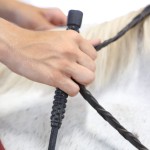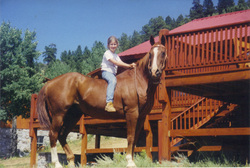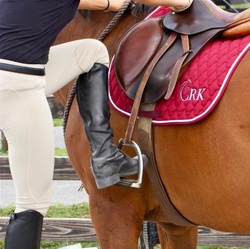Rein handling is one of the most essential skills of riding. Our reins provide communication with the horse at one of the most sensitive areas of their body – the mouth.
In order to use the reins for communication we need to be able to maintain an appropriate length of rein and be able to adjust that length.
Today’s video is going to answer the question of “how long should my reins be?” and give you a simple tutorial on adjusting rein length.
Hit play to watch the video below and then leave a comment with your thoughts or questions!














25 Responses
I love your videos, thank you
Mary McCarthy
I like that you show more than one way
What horse is this?
A well schooled horse, ‘backing’ on a mild signal and very responsive to slight movements of the reins.
My main interests in riding will be Civil War and Revolutionary War reenactments. That means one hands on the reins whilst waving a saber around or aiming a pistol or giving hand signals to the troop. Why is this so infrequently taught to horses and riders?
Please advise me with your expertise and marvelous teaching.
Jingo
Oooops, ONE hand.
Great instruction, as usual. Thanks!
Excellent instruction! Thank you!
I love watching your videos – they are so helpful.
Another great video with multiple great tips, thanks for sharing your knowledge with us!
Great comments. By horse has been ridden both English n western. He is a large strong willed forward but lazy horse who likes slight contact in both types. On trails we mostly soft rein. But when being worked he needs more contact. Thanks forf the videos!
Amazing, such great instruction!!!
Another great and informative video thank you very much callie
Incredibly helpful video as always! Do you have suggestions on shortening/lengthening the rains during transitions?
A very helpful summary, thank you! As far as reign length for a forward horse that is anxious and wants to go to fast, I just read an excellent article by Julie Goodnight in the September issue of “Northwest Rider”. The article is entitled: Explosive Canter Departures: Learning to let go and allow the horse to move forward. While it addresses a very specific problem, I wanted to share this here since you mentioned riding an anxious and forward horse on a shorter reign. In the horse and rider pair referred to in the article, this made the problem worse, because the rider had inadvertently created the anxiety and explosive behavior in the horse by holding him back after she had asked for canter. Once the rider overcame her fear and let the horse move out on a more relaxed reign, the horse calmed down. Again, I know this is very specific and not what you talked about in your video, but I just wanted to share since I am learning to correct this in my own, very forward, mare, by allowing her to stretch more on a longer reign. It takes some getting used to as an English rider practicing dressage! I enjoy all your videos very much! Wish I could come to the East Coast to visit you!
Hi Callie – I wondered if you could do a video on trotting and cantering downhill? It seems so scary! I can sit the trot on a very slight downhill but always tip forward – is it better to lean back slightly? Thanks!
Hi, Callie, thank you very much for all the videos. I am from Rio de Janeiro, Brazil, and started to lear how to ride recently. I am 53 years old and your lessons have helped me a lot! Gos bless yoy!
Best Regarsds,
Isabel
How do you deal with a horse that leans on the rein? I do strong half halts. I use my stomach muscles and seat rather than the hand. I try to keep him off the forehand.
Hi Jill,
Try doing a number of turns, especially square turns – think zig zag around the arena instead of doing circles or following the fence.
I will try this. Thankyou so much for replying.
I love your teaching method. Very well explained and easy to follow. Please keep up the good work.
Jill xxx
Hello. I am a very new rider(adult). One thing I’m having a lot of trouble with is keeping my reigns short and leaning back in the canter at the same time. My instructor says I can’t let the reigns too lose in canter but if try to shorten the reigns a bit my arms go forward and then my back comes a bit forward which spoils my canter seat and makes me stiff. I just can’t figure out the appropriate arm length in canter , while maintaining a proper canter seat. Any advice would be much appreciated . Thank you.
Polly, my recommendation would be if you could think about pushing into the neck with your hands and that will help sink your hips back and keep space between the horse and your upper body!
Let me know if this helps!
– Julia Burdy, CRK Training Community Manager
Hello!
I found this video because I stared riding dressage with a new instructor and had some questions. I tend to “shimmy” the reins in either hand to shorten or lengthen as using two hands on a western rein is a fault. She advised that it is unsafe to do so, but is it ok to make small adjustments by wiggling the reins to your desired length? The pinch and pull seems tedious to do for every adjustment. Thanks for your advice!!
Hi Emily, it is not good practice to shorten the reins by wiggling them – it creates a drop in contact and the potential to lose a rein if something happens with the horse in the moment the riders hand is open to wiggle the rein shorter. The pinch and slide will not be tedious at all with practice and allows for a smooth and efficient way to adjust the length of your reins!
I have found too that one horse i ride for lessons works better when my reins are slightly longer and another is fine when shorter.
Has taken practise and now i can shortened each rein separately. Great concise and informative “lesson” Callie. Love your work
Great insight Cheryl!
-Julia, CRK Training Community Manager